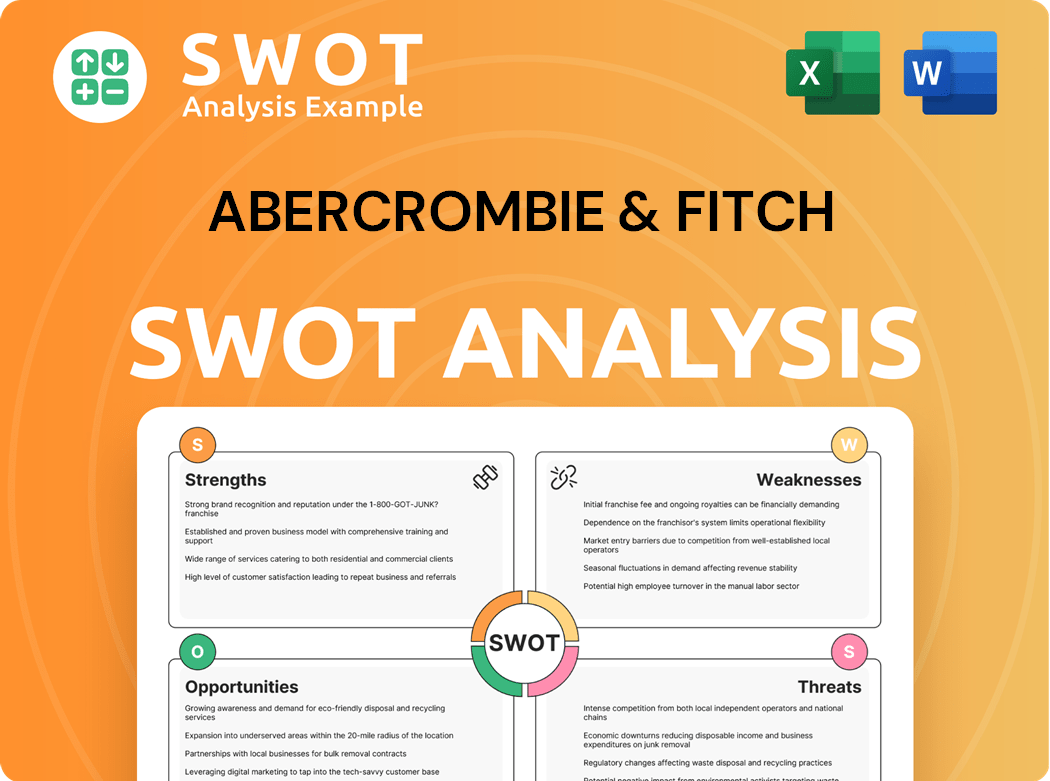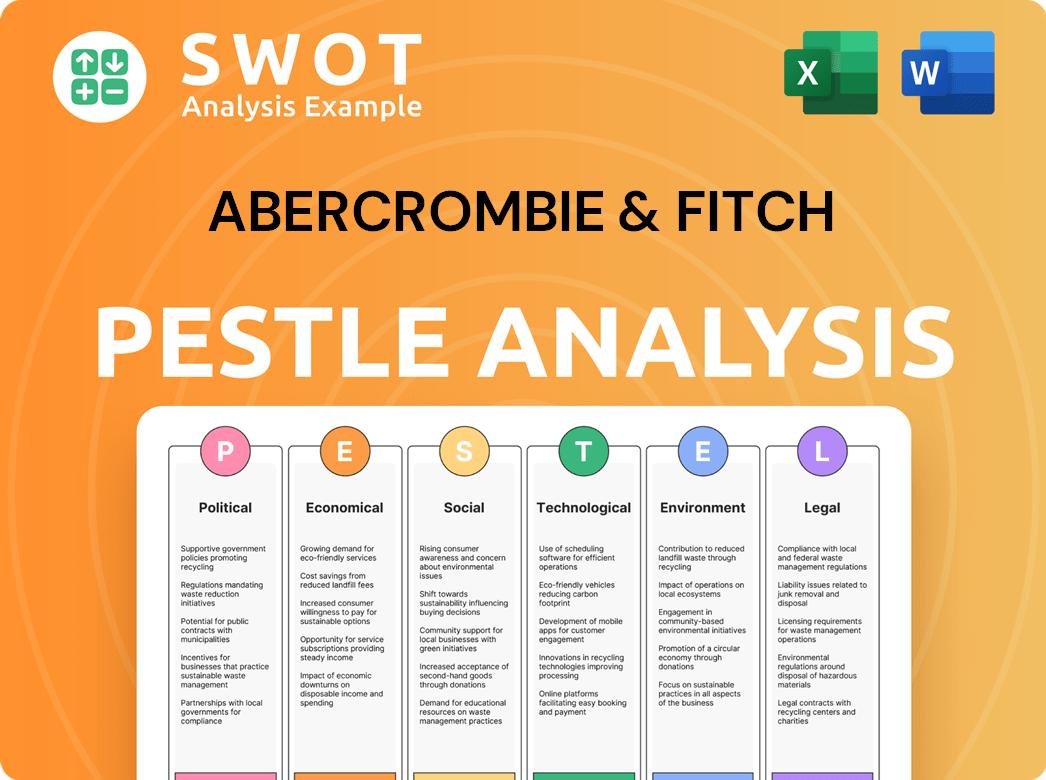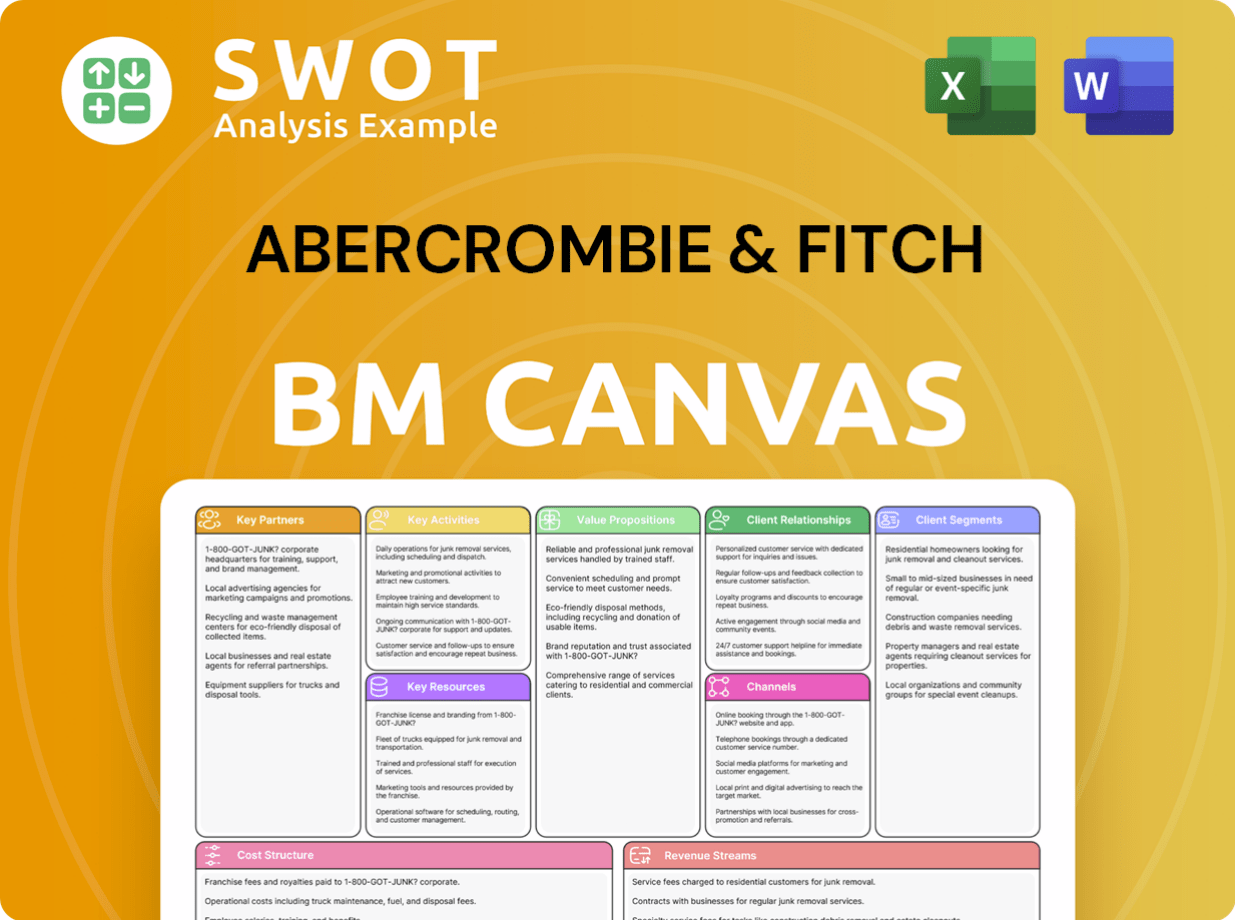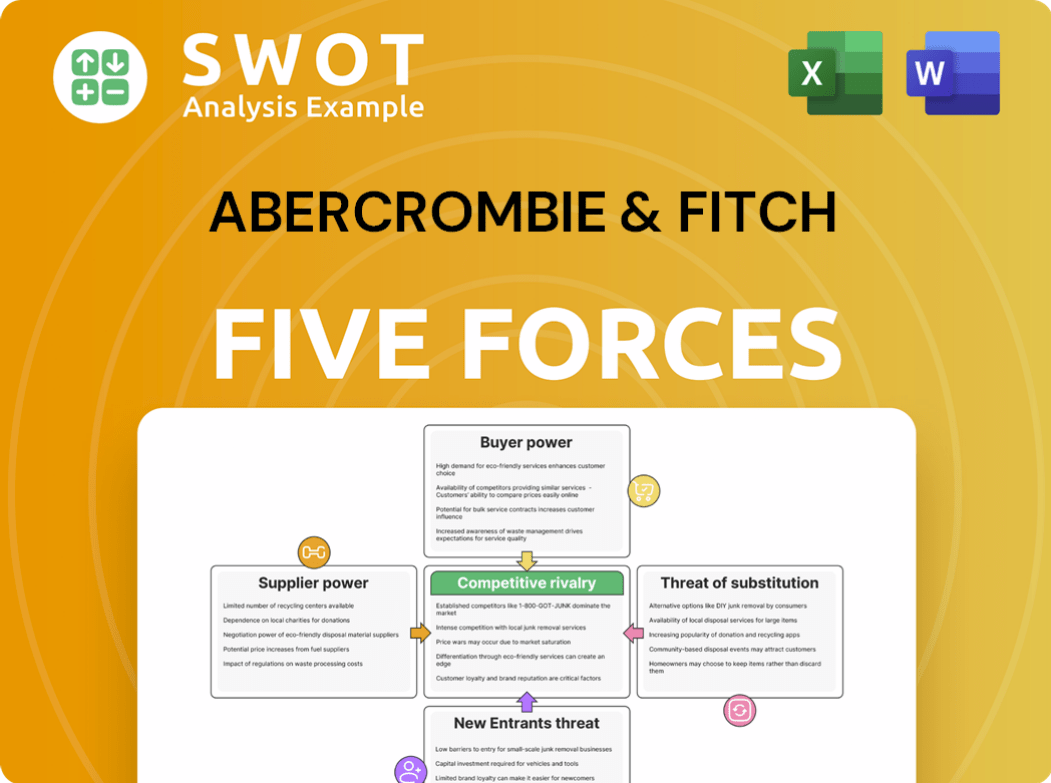Abercrombie & Fitch Bundle
How Has Abercrombie & Fitch Redefined Its Customer?
Understanding the ever-changing landscape of customer demographics and target markets is crucial for any brand aiming for longevity. Abercrombie & Fitch (A&F), a retail giant, offers a fascinating case study in adapting to shifting consumer preferences. From its origins to its current multi-brand strategy, A&F's journey highlights the critical importance of knowing your customer. This is a deep dive into how Abercrombie & Fitch has evolved to meet the needs of its target audience.

Abercrombie & Fitch's evolution showcases the power of strategic adaptation in the retail industry. Analyzing its Abercrombie & Fitch SWOT Analysis reveals how the company has navigated challenges by understanding its customer demographics and refining its brand positioning. By examining the Abercrombie & Fitch target market, including factors such as customer age range, gender, and lifestyle, we can understand the shifts in consumer behavior. This exploration delves into the company's market segmentation and ideal customer profile, providing insights into Abercrombie & Fitch's success.
Who Are Abercrombie & Fitch’s Main Customers?
Understanding the customer demographics and target market of the company is crucial for its success. The company, through its various brands, strategically aims at different age groups. This approach allows the company to cater to a wide range of consumers, from teenagers to young adults, ensuring relevance and driving sales.
The primary customer segments are defined by age and lifestyle. The company's brand positioning has evolved to meet changing consumer preferences, focusing on inclusivity and body positivity. This shift is evident in its marketing strategies and product offerings, which aim to resonate with a broader audience.
The company's brands each have a distinct target market. Abercrombie & Fitch, including Abercrombie Kids, focuses on older teens and young adults, specifically those aged 18-24. Hollister Co. targets high school students and teenagers, while Gilly Hicks caters to customers interested in intimate apparel and activewear.
The Abercrombie & Fitch brand has broadened its appeal to include young Millennials aged 28-43. This demographic possesses higher disposable incomes, influencing consumer spending habits and brand perception. The company's rebranding efforts have been instrumental in attracting this older segment.
Hollister Co. primarily focuses on high school students and teenagers. This brand's success is evident in its financial performance, as highlighted in the Q1 2025 results. The brand's market segmentation strategy is key to maintaining its relevance and sales growth within this demographic.
Gilly Hicks, a sub-brand under Hollister, offers intimate apparel and activewear, targeting a specific niche within the broader teen and young adult market. This allows the company to capture a wider range of customer preferences. The brand’s focus on these products helps to diversify the company's portfolio.
The company's emphasis on e-commerce and online sales is critical for reaching its target demographics. This approach ensures accessibility and convenience for customers. Digital channels play a vital role in driving sales and brand engagement.
The company’s financial results reflect the effectiveness of its target market strategies. Hollister brands led performance in Q1 2025 with a 22% growth, achieving its best-ever first-quarter net sales. Abercrombie brands saw a 4% decline in Q1 2025 against a strong 31% sales growth in Q1 2024.
- For the full fiscal year 2024, Abercrombie brands delivered 16% net sales growth.
- Hollister brands achieved 15% net sales growth, with comparable sales growth of 15% and 19% respectively.
- The company's success is also influenced by its ability to adapt to market trends and consumer preferences, as explained in the Growth Strategy of Abercrombie & Fitch article.
- Understanding the customer demographics, including factors such as customer age range and customer income levels, is essential for effective market segmentation.
Abercrombie & Fitch SWOT Analysis
- Complete SWOT Breakdown
- Fully Customizable
- Editable in Excel & Word
- Professional Formatting
- Investor-Ready Format

What Do Abercrombie & Fitch’s Customers Want?
Understanding customer needs and preferences is central to the current strategy of the company. This approach marks a significant shift from its past, focusing on quality, comfort, and inclusivity. The goal is to offer enduring products that allow customers to express their individuality.
The company's focus on quality and comfort resonates with socially and environmentally conscious shoppers. The launch of eco-friendly clothing lines is a direct response to these preferences. Purchasing decisions are influenced by psychological, practical, and aspirational factors, guiding the brand's strategies.
The brand employs a value-based pricing strategy, aiming to make its products accessible while reflecting perceived value. The company invests in enhancing both in-store and online shopping experiences. This includes personalized recommendations and actively gathering customer feedback to inform product development.
The company has transitioned to prioritize customer needs, emphasizing quality, comfort, and inclusivity. This shift is a key element in its brand positioning, aiming to attract a broader consumer profile. This approach is essential for understanding the customer demographics and target market.
The brand offers products of enduring quality and exceptional comfort, supporting customers in expressing their individuality. Eco-friendly clothing lines cater to environmentally conscious consumers. This strategy aligns with current market segmentation trends.
A value-based pricing strategy ensures products are accessible while reflecting their perceived value. This approach is crucial for attracting the target market. Consumer spending habits are carefully considered in this strategy.
The company actively enhances both in-store and online shopping experiences. Technology is used to provide tailored product recommendations and styling advice. This enhances the brand perception among consumers.
The 'Read & React' inventory model enables the company to quickly respond to popular items. This agility was crucial to its success in 2024. This approach is part of the market research report.
Marketing and product features are tailored to specific segments. Email content is personalized based on user type, loyalty status, purchase history, and browsing behavior. This strategy is designed to address the Abercrombie & Fitch customer preferences.
The company's success in 2024 was significantly influenced by its ability to adapt to customer preferences and buying behaviors. The 'Read & React' inventory model played a crucial role in this, allowing the company to quickly restock popular items. The brand's focus on personalized marketing, tailoring content to specific customer segments, is a key element in its strategy. For more insights into the competitive landscape, consider reading about the Competitors Landscape of Abercrombie & Fitch.
The brand's approach to understanding and responding to customer needs is multifaceted, encompassing product development, pricing, and marketing. These strategies are designed to align with the Abercrombie & Fitch ideal customer profile.
- Quality and Comfort: Prioritizing enduring quality and exceptional comfort.
- Inclusivity: Offering products that support customers in expressing their individuality.
- Value-Based Pricing: Ensuring products are accessible while reflecting perceived value.
- Immersive Experiences: Enhancing both in-store and online shopping experiences.
- Personalized Marketing: Tailoring content based on customer data.
Abercrombie & Fitch PESTLE Analysis
- Covers All 6 PESTLE Categories
- No Research Needed – Save Hours of Work
- Built by Experts, Trusted by Consultants
- Instant Download, Ready to Use
- 100% Editable, Fully Customizable

Where does Abercrombie & Fitch operate?
The geographical market presence of Abercrombie & Fitch Co. is extensive, with approximately 790 stores globally. These stores are spread across North America, Europe, Asia, and the Middle East. The company also utilizes e-commerce platforms to reach a wider customer base.
The company's strategic plan, 'Always Forward,' emphasizes global growth as a key objective. Abercrombie & Fitch's expansion strategy is evident in its recent performance and future plans. This includes both physical store openings and strategic partnerships.
In the first quarter of 2025, Abercrombie & Fitch experienced broad-based net sales growth across different regions. The Americas saw a 7% increase, EMEA (Europe, the Middle East, and Africa) grew by 12%, and APAC (Asia-Pacific) increased by 5%. For the full fiscal year 2024, the Americas led with a 17% increase in net sales, followed by EMEA at 12% and APAC at 9%.
The UK and Germany are significant markets within EMEA for Abercrombie & Fitch. The company has invested heavily in these regions, resulting in positive outcomes. This includes the opening of new stores to cater to the local customer demographics.
Abercrombie & Fitch expanded its market reach by entering India through a strategic franchise partnership in December 2024. This move is part of the company's broader strategy to tap into emerging markets and broaden its target market.
Abercrombie & Fitch aims to be a net store opener in 2025. The company plans to open approximately 60 new stores, significantly outpacing the anticipated 20 closures. This expansion strategy reflects the company's confidence in its brand positioning.
The company is actively exploring further international opportunities. Corporate teams are based in London for the UK and European business (particularly Germany) and in Shanghai for the APAC region. This strategic positioning supports localized market segmentation efforts.
Abercrombie & Fitch Business Model Canvas
- Complete 9-Block Business Model Canvas
- Effortlessly Communicate Your Business Strategy
- Investor-Ready BMC Format
- 100% Editable and Customizable
- Clear and Structured Layout

How Does Abercrombie & Fitch Win & Keep Customers?
The company focuses on robust customer acquisition and retention strategies, heavily leveraging digital channels and personalized experiences. A key element of their approach is increased investment in marketing, with spending rising to 5% of sales in Q1 2024, up from 4% in the prior year. These marketing efforts span the entire customer journey, from initial awareness to final purchase and beyond.
Influencer marketing is a significant component of its strategy, particularly on platforms like TikTok and Instagram, where they engage with their digitally-native customer base. The company partners with influencers whose styles align with the brand's ethos of casual luxury and inclusivity. Additionally, social media campaigns and live events are used to introduce new product categories and drive customer growth and retention. Partnerships with entities such as Formula One and the NFL further support their efforts to attract and retain customers.
For customer retention, the myAbercrombie loyalty program is a crucial driver, with over 70% of its customer base enrolled as of 2024. This program provides early access to product drops, targeted discounts, and personalized recommendations. The company's CRM system utilizes this data for high-performing email and SMS campaigns, including browse and cart abandonment recovery, and product launch announcements tailored to past behavior. Since 2023, the company has been experimenting with AI-powered product recommendations in email and app messaging, leveraging first-party data to enhance the customer experience.
The company's increased investment in digital marketing is a core strategy for customer acquisition. This includes a significant focus on social media marketing, influencer collaborations, and targeted advertising campaigns. These efforts are designed to reach the target market effectively and drive traffic to both online and physical stores. The company's marketing spending rose to 5% of sales in Q1 2024, indicating a commitment to expanding its customer base.
- Social Media Marketing: Utilizing platforms like Instagram and TikTok to engage with the target demographic.
- Influencer Collaborations: Partnering with influencers to promote products and reach a wider audience.
- Targeted Advertising: Implementing data-driven advertising campaigns to reach potential customers.
- Email Marketing: Sending personalized emails to customers based on their past behavior and preferences.
The myAbercrombie loyalty program is a key component of its customer retention strategy. The program offers various benefits to encourage repeat purchases and build customer loyalty. This includes early access to new products, exclusive discounts, and personalized recommendations based on customer preferences and past purchases. As of 2024, over 70% of their customer base is enrolled in this program, demonstrating its effectiveness.
The company has been experimenting with AI-powered product recommendations in email and app messaging since 2023. This technology uses first-party data to analyze customer behavior and preferences, providing personalized product suggestions. This strategy aims to enhance the customer experience and drive sales by suggesting products that customers are most likely to purchase. This data-driven approach is a key element of its digital transformation.
The 'Always Forward' strategic plan, introduced in June 2022, is designed to drive focused brand growth, facilitate an enterprise-wide digital revolution, and maintain financial discipline. This strategic plan contributes significantly to customer acquisition and retention efforts. The company's commitment to customer-centric strategies, data-driven decision-making, and operational efficiency underscores its approach to long-term success.
The company plans to continue its quarterly share repurchase program, targeting $100 million per quarter in 2025. This demonstrates confidence in its financial health and commitment to shareholder value. This financial strategy helps to boost investor confidence and supports the company's overall growth objectives. This also reflects the company's strong financial position and its commitment to delivering value to its shareholders.
Abercrombie & Fitch Porter's Five Forces Analysis
- Covers All 5 Competitive Forces in Detail
- Structured for Consultants, Students, and Founders
- 100% Editable in Microsoft Word & Excel
- Instant Digital Download – Use Immediately
- Compatible with Mac & PC – Fully Unlocked

Related Blogs
- What are Mission Vision & Core Values of Abercrombie & Fitch Company?
- What is Competitive Landscape of Abercrombie & Fitch Company?
- What is Growth Strategy and Future Prospects of Abercrombie & Fitch Company?
- How Does Abercrombie & Fitch Company Work?
- What is Sales and Marketing Strategy of Abercrombie & Fitch Company?
- What is Brief History of Abercrombie & Fitch Company?
- Who Owns Abercrombie & Fitch Company?
Disclaimer
All information, articles, and product details provided on this website are for general informational and educational purposes only. We do not claim any ownership over, nor do we intend to infringe upon, any trademarks, copyrights, logos, brand names, or other intellectual property mentioned or depicted on this site. Such intellectual property remains the property of its respective owners, and any references here are made solely for identification or informational purposes, without implying any affiliation, endorsement, or partnership.
We make no representations or warranties, express or implied, regarding the accuracy, completeness, or suitability of any content or products presented. Nothing on this website should be construed as legal, tax, investment, financial, medical, or other professional advice. In addition, no part of this site—including articles or product references—constitutes a solicitation, recommendation, endorsement, advertisement, or offer to buy or sell any securities, franchises, or other financial instruments, particularly in jurisdictions where such activity would be unlawful.
All content is of a general nature and may not address the specific circumstances of any individual or entity. It is not a substitute for professional advice or services. Any actions you take based on the information provided here are strictly at your own risk. You accept full responsibility for any decisions or outcomes arising from your use of this website and agree to release us from any liability in connection with your use of, or reliance upon, the content or products found herein.